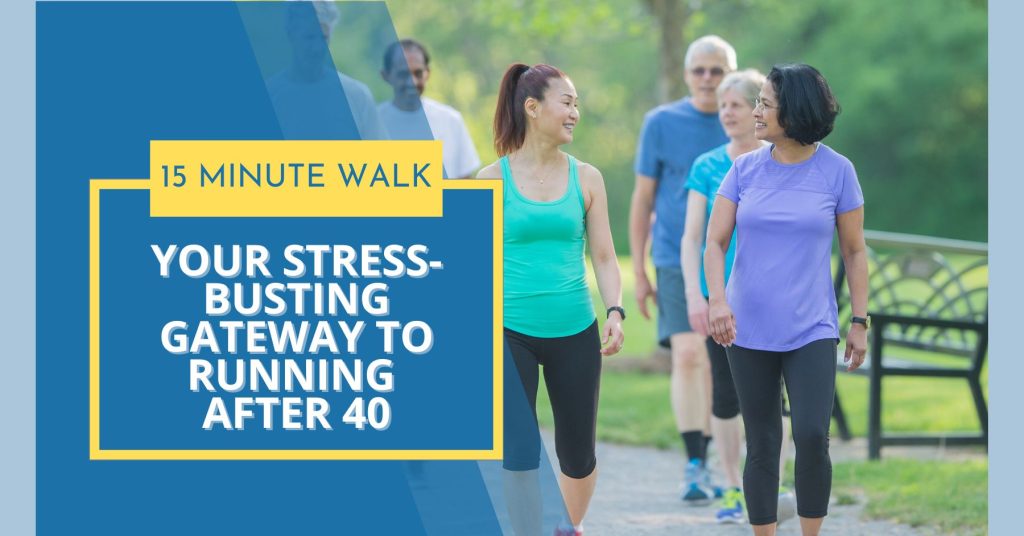Are you feeling overwhelmed by stress and looking for a simple way to boost your fitness after 40? Look no further than the humble 15 minute walk. This easy-to-start exercise is your ticket to better health and reduced stress levels. At Midlife Runners Paradise (MRP), we’ve seen countless individuals transform their lives by taking those first steps. Our MRP framework combines gentle walking and running with strength training, nutrition, and mental well-being techniques. It’s designed specifically for midlife fitness enthusiasts like you. Ready to discover how a quick daily stroll can pave the way to a healthier, happier you? Let’s explore the power of the 15 minute walk and how it can be your gateway to running and overall wellness.
The Power of a 15 Minute Walk
Don’t underestimate the impact of a quick 15 minute walk. This simple activity packs a powerful punch when it comes to your health. Regular walks can significantly lower your risk of obesity, type 2 diabetes, and high blood pressure. But the benefits don’t stop there.
A daily 15 minute walk is a potent stress-buster. It triggers the release of endorphins, your body’s natural mood elevators. Feeling overwhelmed? A brisk walk can clear your mind and reduce anxiety. It’s like hitting the reset button for your brain.
The mental health perks are equally impressive. Walking improves memory, boosts creativity, and enhances overall cognitive function. It’s particularly beneficial for those of us over 40, helping to keep our minds sharp as we age.
Best of all, a 15 minute walk is accessible to almost everyone. No fancy equipment or gym membership required – just a pair of comfortable shoes and a willingness to take that first step. Ready to transform your health with a daily walk?
Starting Your 15 Minute Walking Workout
Ready to kick off your 15 minute walking workout? Let’s break it down into simple steps:
- Warm-up (2 minutes): Start with gentle stretches. Roll your shoulders, swing your arms, and do a few knee lifts. This preps your body and reduces injury risk.
- Main walk (11 minutes): Begin at a comfortable pace. You should be able to talk without getting winded. As you progress, try to pick up the pace slightly.
- Cool-down (2 minutes): Slow your pace gradually. This helps your heart rate return to normal.
Now, let’s talk proper form:
- Stand tall: Imagine a string pulling you up from the crown of your head.
- Look forward: Keep your chin parallel to the ground.
- Engage your core: This supports your back and improves posture.
- Swing arms naturally: Bend elbows at about 90 degrees.
- Roll through your foot: Land on your heel and push off with your toes.
For beginners, focus on consistency rather than speed. Aim for a pace where you’re breathing harder than usual but can still hold a conversation.
Remember, the perfect 15 minute walking workout is one that you’ll do regularly. Start where you are, use what you have, and do what you can. With each step, you’re building a healthier you.
Struggling to find time? Try walking during your lunch break or after dinner. The key is making it a non-negotiable part of your day. Your body and mind will thank you!
Calories Burned in a 15 Minute Walk
Curious about the calorie-burning power of your 15 minute walk? While it may not seem like much, those steps add up! On average, a 15 minute walk can burn between 60 to 100 calories, depending on various factors.
Your weight plays a big role in calorie burn. A person weighing 150 pounds might burn about 70 calories, while someone weighing 200 pounds could burn closer to 90 calories in the same time.
Other factors affecting calorie burn include:
- Walking speed: A brisker pace burns more calories.
- Terrain: Uphill walks increase calorie burn.
- Age and fitness level: Generally, younger and fitter individuals burn fewer calories as they’re more efficient.
But don’t fixate on the numbers! The real magic of a 15 minute walk lies in its impact on your metabolism. Regular walking can boost your metabolic rate, helping you burn more calories throughout the day.
Remember, consistency is key. Those 15 minute walks, done regularly, contribute significantly to weight management and overall health. It’s not just about the calories burned during the walk, but the positive changes you’re making to your lifestyle.
From 15 Minute Walks to Running: A Gradual Transition
Ready to take your 15 minute walks to the next level? Transitioning to running is an exciting step, but remember: slow and steady wins the race, especially for those of us over 40.
Start by maintaining your 15 minute walk routine for at least a few weeks. Once you’re comfortable, try this gradual progression:
- Week 1-2: During your 15 minute walk, add 30 seconds of light jogging every 5 minutes.
- Week 3-4: Increase to 1 minute of jogging every 5 minutes.
- Week 5-6: Try 2 minutes of jogging, 3 minutes of walking. Repeat.
Listen to your body. If you need more time at any stage, take it. There’s no rush!
Key tips for a smooth transition:
- Invest in proper running shoes to protect your joints.
- Focus on your form: short strides, land mid-foot, keep your upper body relaxed.
- Stay hydrated and warm up properly.
- Rest days are crucial. They allow your body to recover and adapt.
For those over 40, this gradual approach is vital. Our bodies need more time to adjust to increased impact. By slowly building up, you’re reducing injury risk and setting yourself up for long-term success.
Remember, the goal isn’t to become a marathon runner overnight. It’s about improving your fitness, one step at a time. Celebrate each milestone, whether it’s your first full minute of running or your first 5-minute jog. You’re making progress, and that’s what counts!
Stress Reduction Techniques During Your 15 Minute Walk
Transform your 15 minute walk into a powerful stress-busting session with these simple techniques:
- Mindful Walking: Focus on each step. Feel your feet touching the ground and the rhythm of your movement. This anchors you to the present, easing worries about the past or future.
- Deep Breathing: Take slow, deep breaths as you walk. Inhale for four steps, exhale for four. This activates your body’s relaxation response.
- Gratitude Practice: With each step, think of something you’re grateful for. This shifts your mind from stressors to positives in your life.
- Nature Connection: If possible, walk in green spaces. Notice the trees, birds, or sky. Nature exposure significantly reduces stress hormones.
- Body Scan: Mentally scan your body from head to toe, releasing tension in each area as you go.
- Positive Affirmations: Repeat empowering phrases like “I am calm and capable” with each step.
Remember, your 15 minute walk isn’t just physical exercise—it’s a mental wellness break. By incorporating these techniques, you’re not only reducing stress but also building resilience for future challenges. Give them a try and see which works best for you!
Nutrition Tips to Complement Your 15 Minute Walk
Fueling your body right can boost the benefits of your 15 minute walk. Here are some simple nutrition tips to keep you energized and support recovery:
- Hydrate: Drink water before and after your walk. Even mild dehydration can zap your energy.
- Pre-walk snack: If you’re low on energy, try a small banana or a handful of nuts about 30 minutes before walking.
- Post-walk refuel: Within an hour after your walk, have a balanced snack with carbs and protein. Greek yogurt with berries or whole-grain toast with avocado are great options.
- Balanced meals: Focus on whole foods throughout the day. Include lean proteins, whole grains, and plenty of colorful fruits and veggies.
- Timing matters: Avoid heavy meals right before your walk. A too-full stomach can lead to discomfort.
- Electrolytes: If you’re walking in hot weather, consider a drink with electrolytes to replace what you lose through sweat.
Remember, good nutrition isn’t about perfection. Small, consistent changes can make a big difference in how you feel during and after your 15 minute walk. Listen to your body and adjust as needed. You’re nourishing yourself for better health with every step and every bite!
Conclusion
A 15 minute walk may seem simple, but its benefits for stress reduction and overall health are profound, especially for those over 40. Walking for just 15 minutes a day can lower stress levels, improve mood, and provide a much-needed mental break. It’s also an easy and effective way to start incorporating movement into your routine, laying the groundwork for more active pursuits like running. By making a 15 minute walk part of your daily life, you’ll not only reduce stress but also improve your fitness and well-being in the long run.
If you’re over 40 and looking for a beginner-friendly way to start running, our Gentle Couch to 5K Program with Raji Sundar is designed just for you. Reimagine your health and fitness at 40 or 50 with a clear, gentle plan that makes running both attainable and enjoyable. After completing the program, you’ll run comfortably without feeling breathless, enjoying your morning jogs with newfound energy. You’ll experience better stamina, improved energy levels, and even relief from premenopausal symptoms. Running can become your way to release stress, lose fat, and feel fitter and happier in your daily life.





